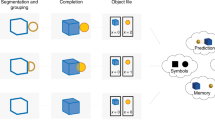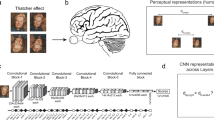Abstract
A novel approach to object recognition and scene analysis based on neural network representation of visual schemas is described. Given an input scene, the VISOR system focuses attention successively at each component, and the schema representations cooperate and compete to match the inputs. The schema hierarchy is learned from examples through unsupervised adaptation and reinforcement learning. VISOR learns that some objects are more important than others in identifying the scene, and that the importance of spatial relations varies depending on the scene. As the inputs differ increasingly from the schemas, VISOR's recognition process is remarkably robust, and automatically generates a measure of confidence in the analysis.
Similar content being viewed by others
References
M.A. Arbib.The Metaphorical Brain 2: Neural Networks and Beyond, Wiley, New York, 1989.
I. Biederman. Recognition-by-components: A theory of human image understanding,Psychological Review, vol. 94, pp. 115–147, 1987.
T.O. Binford. Survey of model-based image analysis systems,Robotics Research, vol. 1, pp. 18–64, 1982.
A.C. Bovik, M. Clark, W.S. Geisler. Computational texture analysis using localized spatial filtering,Proceedings of the Workshop on Computer Vision, pp. 201–206, 1987.
G.A. Carpenter, S. Grossberg. A massively parallel architecture for a self-organizing neural pattern recognition machine,Computer Vision, Graphics, and Image Processing, vol. 37, pp. 54–115, 1987.
B.A. Draper, R.T. Collins, J. Brolio, A.R. Hanson, E.M. Riseman. The Schema System,International Journal of Computer Vision, vol. 2, pp. 209–250, 1989.
J.A. Feldman. Four frames suffice: A provisional model of vision and space,Behavioral and Brain Sciences, vol. 8, pp. 265–313, 1985.
A.R. Hanson, E.M. Riseman. VISIONS: A computer system for interpreting scenes, in: A.R. Hanson, E.M. Riseman eds.,Computer Vision Systems, Academic Press, New York, 1978.
G.E. Hinton. Mapping part-whole hierarchies into connectionist networks,Artificial Intelligence, vol. 46, pp. 47–75, 1990.
J.E. Hummel, I. Biederman. Dynamic binding in a neural network for shape recognition,Psychological Review, vol. 99, pp. 480–517, 1992.
W.K. Leow.VISOR: Learning Visual Schemas in Neural Networks for Object Recognition and Scene Analysis, PhD thesis, Department of Computer Sciences, The University of Texas at Austin, 1994.
W.K. Leow, R. Miikkulainen. Priming, perceptual reversal, and circular reaction in a neural network model of schema-based vision,Proceedings of the 16th Annual Conference of the Cognitive Science Society, 1994.
D.E. Rumelhart, P. Smolensky, J.L. McClelland, G.E. Hinton. Schemata and sequential thought processings in PDP models, in: J.L. McClelland, D.E. Rumelhart eds.,Parallel Distributed Processings, MIT Press, Cambridge, Massachusetts, 1986.
J.K. Tsotsos. Image understanding, in: S.C. Shapiro ed.,Encyclopedia of Artificial Intelligence, Wiley, New York, 1987.
Author information
Authors and Affiliations
Rights and permissions
About this article
Cite this article
Leow, W.K., Miikkulainen, R. VISOR: Schema-based scene analysis with structured neural networks. Neural Process Lett 1, 18–23 (1994). https://doi.org/10.1007/BF02310938
Issue Date:
DOI: https://doi.org/10.1007/BF02310938




